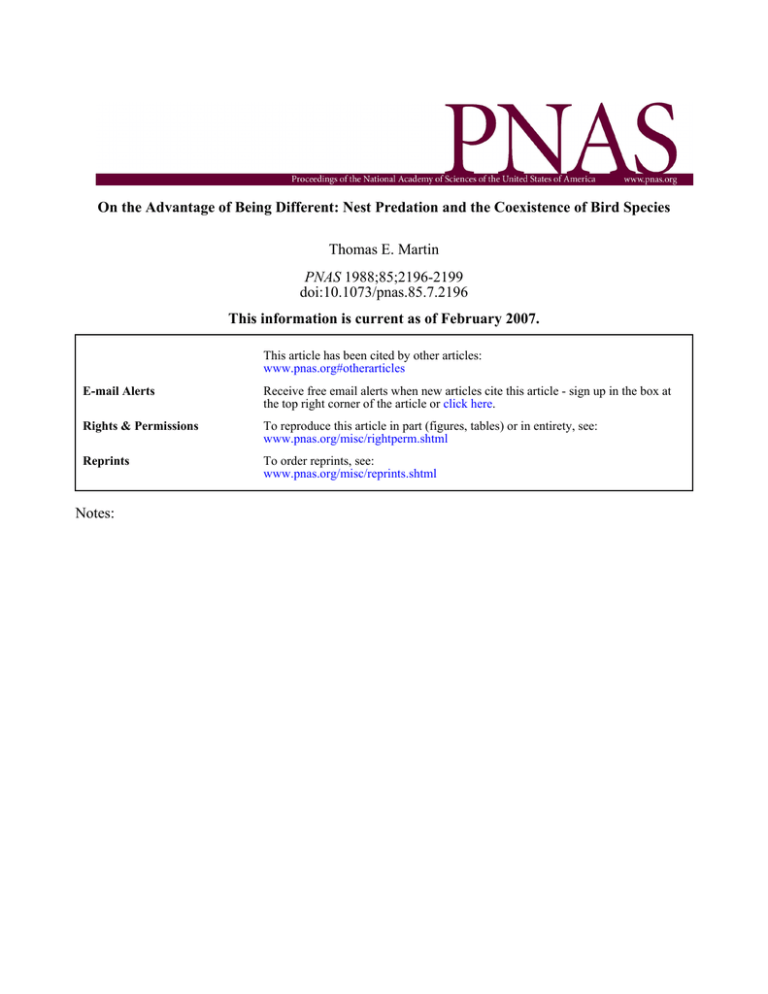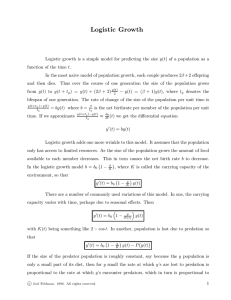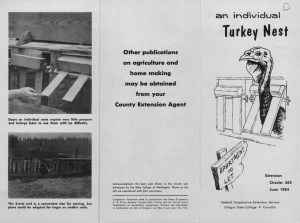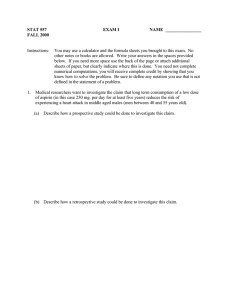On the Advantage of Being Different: Nest Predation and the... This information is current as of February 2007. Thomas E. Martin 1988;85;2196-2199
advertisement

On the Advantage of Being Different: Nest Predation and the Coexistence of Bird Species Thomas E. Martin PNAS 1988;85;2196-2199 doi:10.1073/pnas.85.7.2196 This information is current as of February 2007. This article has been cited by other articles: www.pnas.org#otherarticles E-mail Alerts Receive free email alerts when new articles cite this article - sign up in the box at the top right corner of the article or click here. Rights & Permissions To reproduce this article in part (figures, tables) or in entirety, see: www.pnas.org/misc/rightperm.shtml Reprints To order reprints, see: www.pnas.org/misc/reprints.shtml Notes: Proc. Nati. Acad. Sci. USA Vol. 85, pp. 21%-2199, April 1988 Ecology On the advantage of being different: Nest predation and the coexistence of bird species (community structure/density-dependent predation/resource partitioning/search images) THOMAS E. MARTIN Department of Zoology, Arizona State University, Tempe, AZ 85287-1501 Communicated by Jared M. Diamond, December 23, 1987 tors will increase for individual species with the cumulative density of all similar species (ref. 17; also see refs. 23 and 24). Thus, such behavioral responses by the predators, if they exist, can favor coexistence of species that use different nesting sites (partitioning of resources, where nest sites are the resource) to minimize cumulative density effects (17). Here, I report experiments that support the premise that predator search intensity increases with the frequency of occupied nest sites (reward rate). I then show that, for a given density of nests, nest predation is reduced when those nests are placed in sites that differ (partitioned nesting space) than when placed in similar sites (unpartitioned space). A long-standing debate in ecology centers on ABSTRACT identifying the processes that determine which species coexist in a local community. Partitioning of resources, where species differ in resource use, is often thought to reflect the primary role of competition in determining coexistence of species. However, in theory predation can favor similar patterns. This theory premises that predators increase their search intensity with increasing density of prey. One set of experiments reported here supports this premise based on predators that search for bird nests. A second set of experiments documents that preda. tion rates are lower when nest sites are partitioned among different sites than when the same number of nests are placed in similar sites. Moreover, predation rates on experimental nests are more similar to rates on real nests when experimental nests are partitioned among different sites. These results provide support for a hypothesis that nest predation is a process that can favor coexistence of bird species that partition resources, where nest sites are the resources. STUDY AREA AND METHODS Study Area. Experiments were conducted in four mixedconifer drainages in central Arizona at -2300-m elevation. These drainages were of the same vegetation type and general location as other sites on which I have been studying nest predation (25, 26). Nest predators were identified using cameras outfitted with infrared light beams that trigger the camera when the beam is broken. Ten cameras were set up at artificial nests that were in the same drainages as experimental nests but which were not included in the results presented here. Preliminary results based on 11 pictures indicated that the nest predators were red squirrels (Tamiasciurus hudsonicus) and gray-neck chipmunks (Tamias cinereicollis). These results coincide with my impressions on these sites from observations of birds chasing these two predators. However, other predators are also on the sites [e.g., long-tailed weasels (Mustelafrenata) and Steller's jays (Cyanocitta stelleri)] and undoubtedly account for some nest losses. Experiments used artificial wicker nests baited with quail (Coturnix coturnix) eggs. Artificial nests have been successfully used in other studies to examine predation rates (27, 28). Moreover, I previously tested potential biases associated with using artificial nests in the habitats studied here and found that nests that simulate the appearance and position of real nests can elicit predation responses that reflect real trends (29). Experiment 1. This experiment tested the response of predators to reward frequency by modifying the frequency of egg-occupied nests in three treatments. In all treatments a constant number of nests (seven) was placed in small white firs (Abies concolor) in 10-m-diameter circles (referred to as clumps). Ten clumps were used in each treatment and placed about 25 m apart. Treatments were separated by 100 m. One, three, and all seven nests in each clump contained eggs in treatments one, two, and three, respectively. Thus, this design used 70 nests per treatment with 10, 30, and 70 nests containing eggs in treatments one, two, and three, respectively. Experiment 2. This experiment tested the effect of nest space partitioning on predation rates. Four species were simulated. One nest type simulated an orange-crowned warbler (Vermivora celata) and was placed in a small de- Local processes determine the number and types of species that coexist in a local'community, within regional and historical constraints on availability of species (1). Competition is an example of a local process. In fact, resource partitioningi.e., differences among coexisting species in their use of resources-is commonly observed and often thought to reflect the primary role of competition in determining coexistence of species (2-5). However, the importance of competition has been hotly debated, creating a need to examine alternative processes (6-9). Predation is an alternative process that can affect coexistence of species by mediating competitive interactions or by eliminating species (10-14). More importantly, theory suggests that predation can also favor resource partitioning similar to competition (15-17). Thus, this theory provides an alternative explanation for a common pattern (i.e., resource partitioning). Here, I test whether nest predators exhibit the behaviors that can favor resource partitioning among coexisting bird species. Nest predation is probably an important agent of natural selection for birds because such predation commonly is a primary limit on reproductive succes's (18). However, the effect of predators depends on their searching behavior (17). Predators, in searching for bird nests, must examine some potential nest sites that are not occupied by eggs (no reward). Increased reward frequency should reinforce search behavior. Consequently, both search intensity and the proportion of nests lost to predators should increase with the frequency or density of occupied nest sites (reward rate). Moreover, predators can enhance their search efficiency by specializing on prey types and learning search images (19-22). If predators do not discriminate among species with similar nest sites, then the proportion of nests lost to predaThe publication costs of this article were defrayed in part by page charge payment. This article must therefore be hereby marked "advertisement" in accordance with 18 U.S.C. §1734 solely to indicate this fact. 2196 Proc. Natl. Acad. Sci. USA 85 (1988) Ecology: Martin pression in the ground under the stem of a deciduous shrub (usually big-toothed maple-Acer grandidentatum) (termed ground species). The second nest type simulated a hermit thrush (Catharus guttatus); it was covered with moss and placed about 1 m above ground in a small white fir (termed fir species). The third type was unmodified and placed 1 m above ground in maple [termed maple (1m) species], simulating a MacGillivray's warbler (Oporornis tolmiei). The fourth type was placed 3 m above ground in maple [termed maple (3m) species] simulating a black-headed grosbeak (Pheucticus melanocephalus). Nests were placed at =10-m intervals along two parallel transects (long continuous strips of sample area) that were a minimum of 25 m apart; exact distance between transects and among nests on a transect varied depending on the availability of a suitable nest site. The same spacing was used in both of two treatments (to be described) to maintain constant density between treatments. Both treatments were included in each of three spatial replicates. Treatments were separated by 100 m in each replicate, and spatial replicates were separated by 3-5 km. Experiments in all three spatial replicates were initiated at the end of May when egg-laying activity peaks. The experiments were then repeated in late June when many birds were renesting. This design used 80 nests per spatial replicate (40/treatment) or 240 nests per temporal replicate, with 480 nests used overall. Treatment one simulated a four-species assemblage (partitioned nesting sites). The four nest types were alternated sequentially along the two transects in each replicate, using 40 nests per replicate. Treatment two simulated a singlespecies assemblage (unpartitioned sites); 20 nests of one species were placed along the transects followed by a 100-m buffer and then a second set of 20 nests of a different species for a total of 40 nests in this treatment. This design, which only tested two single species per temporal replicate, was used to maintain constant sample size (40 nests) between treatments and because of time and space constraints on putting out additional nests. The ground species was tested in both temporal replicates to test for any temporal biases. The other single species tested in the first and second temporal replicates were the fir and maple (1m) species, respectively. Thus, three of the four species were tested as 2197 -J 0 6 12 9 15 DAYS EXPOSED FIG. 1. Predation rate as a function of the ratio of egg-occupied nests to total nests in a clump. The three treatments include one, three, and seven nests containing eggs in each clump. (a) Percentage of clumps remaining without any nests in the clump losing eggs to predators. (b) Percentage of intact nests remaining (no egg loss to predators). arguably reflect an increasing probability of random encounacross treatments. However, the risk to individual nests is shown by the percentage of intact nests (no egg loss) that were remaining at each nest check; the results show that even individual nests had a greater rate of predation (F = 6.08, P < 0.02) with increases in reward frequency (Fig. lb). Experiment 2. Predation rates were greater (F = 515.89, P < 0.03) in the single-species treatment across all spatial and temporal replicates (Fig. 2). The higher predation rates could ters of nests Temporal Replicate 1 Temporal Replicate 2 0-O Multiple species 1 00*@-4 Single species z 0 single species. Statistical Tests. Predation rates on artificial nests were measured by examining loss of eggs from nests every 3 days during 15 days of exposure to predators. Differences among treatments were examined by comparing the percentage of nests remaining without having lost any eggs to predators. These data were arcsine-transformed and analyzed by one-, two-, or three-way, repeated measures, analysis of variance (ANOVA). One-way analyses were used for the first experiment. Two-way analyses were used in the second experiment for those comparisons that did not include temporal replications. Otherwise, three-way analyses were used. Two- and three-way interactions with treatment effects were not significant (P > 0.10 in all cases). Predation rates on real nests of the four species being simulated were measured by examining loss of eggs every 3-4 days and using the Mayfield method, which measures the proportion of nests that are lost to predators per day (30, 31). Differences in these daily mortality rates between artificial and real nests were tested with the z test (31). 0~ 0 m z z Lii z LAO w 0( 0 io10 W 4 L1Z'~O_ 0L.,4-0 h 0 0~ !O 2 . - 0 RESULTS Experiment 1. Predation rates increased (F - 10.07, P < 0.01) with increased reward frequency when based on the percentage of clumps remaining without any nests losing eggs to predators (Fig. la). Given that the number of nests at risk increased across treatments, then such results may 3 6 9 12 15 0 3 6 9 12 DAYS EXPOSED TO PREDATORS 1 FIG. 2. Percentage of nests that lose no eggs to predators. Each column is a temporal replicate, and each row is a spatial replicate. The multiple species treatment represents the combined predation rate for four species; the single-species treatment combines two sets of single species in each temporal replicate. 2198 Ecology: Martin z 0 Proc. Natl. Acad. Sci. USA 85 (1988) a Ground Species 1 00t Temporal Replicate 1 0--O Multiple species b Fir Species Temporal Replicate 1 1 0op- Multiple species Maple (1 m) Species Temporal Replicate 2 -@ Single species !R 0 w 0A 0-0- 0-I 0 3: Iz z 801 0K 601 \ w l:: 20 IC) -- O+-~ . w z . =- *t 10 LL 00.~ 0 *l- ol z w 4 w 2 \X0-0-0-o oI ol 0 1-.~ '1~ EL 3 3 6 9 12 15 6 9 12 15 DAYS EXPOSED TO PREDATORS 3 6 9 12 15 0 3 6 9 12 15 DAYS EXPOSED TO PREDATORS FIG. 3. Percentage of nests that lose no eggs to predators. Each column is a temporal replicate, and each row is a spatial replicate. (a) Data in each treatment are based only on the nests that simulated the ground species in all spatial and temporal replicates. (b) Data from both treatments are based only on the nests that simulated the fir species for the first temporal replicate and the maple (im) species for the second temporal replicate. have occurred because the species used in this treatment have containing eggs. These results complement other data showgenerally higher predation rates than those in the multipleing that predation rates on real hermit thrush nests are lower species sample; this hypothesis is unlikely because three of when greater numbers of white firs (unoccupied potential the four species were tested in the single-species treatment. nest sites) surround the nests (26). Thus, data from both real However, comparison of predation rates for the individual and artificial nests support the premise that predators modify species used in both treatments allows direct examination of their search behavior in response to the frequency of occuthis potential bias. Such comparisons show that predation pied nests that they encounter. rates are unequivocally greater in the single-species treatment The second set of experiments documents that predators (Fig. 3); predation rates were higher (F = 30.06, P < 0.04) for can exhibit the behaviors necessary to favor partitioning of the ground-nesting species in both temporal replicates (Fig. nesting space; predation rates were reduced when nests 3a) and for the fir species (F = 52.43, P < 0.02) and maple were partitioned among different sites. These results do not = < (im) species (F 18.83, P 0.05) in temporal replicates 1 seem to be an abnormal response of predators to artificially and 2, respectively (Fig. 3b). Moreover, predation rates in the nest densities given that predation rates in the multiplehigh multiple-species treatment were much more similar to predaspecies treatment were similar to predation rates on real tion rates on real nests than in the single-species treatment nests (Table 1). The lower predation rates in the multiple(Table 1). Predation rates can differ among years (unpubspecies treatment as compared with single-species treatment lished data), but such fluctuations should not influence the may arise because the four nest types were so different that general pattern documented here because the results are different predator species specialized on each nest type; these based on controlled treatments. predators may then have simply responded to the different DISCUSSION densities of individual nest types in the two treatments. Photographs of predators at the two nest types (fir and The first experiment documents that predators can increase ground) monitored with cameras suggest this to be an unlikely their searching intensity with increasing frequency of nests Table 1. Mean ± variance in predation rates, measured as daily mortality rates, for the artificial nests in the multiple- and single-species treatments and for real nests of the four species simulated in the treatments Daily mortality rate, nests lost to predators per da-y Multiple-species Single-species treatment Real nests 0.210 ± 0.0004 0.027 ± 0.0002 (17)t ** 0.168 ± 0.0004 0.047 ± 0.0002 (22) ** 0.154 ± 0.0004 0.081 ± 0.0005 (19) * 0.012 ± 0.0001 (8) only on nests monitored during the same season as experiments (1987) and only during the egg stage. *, P < 0.02 and **, P < 0.001 in comparisons between adjacent numbers. tSample size in parentheses, which equals the number of nests observed. treatment 0.075 ± 0.0001 * Ground 0.050 ± 0.0001 Maple (im) 0.068 ± 0.0001 Fir 0.035 ± 0.0001 Maple (3m) Predation rates on real nests are based Ecology: Martin explanation; both red squirrels and chipmunks were detected taking eggs at both nest types (unpublished data). In addition, observations suggest that these same predators also take eggs from the other two nest types (personal observation). The lower predation rate in the multiple-species treatment may instead occur because multiple prey types inhibit development of search images and thereby reduce foraging efficiency (17, 21, 22). Separation of these two possibilites will require more photographic data and additional experiments. Nonetheless, these experimental results show that there can indeed be an advantage to being different; nest predation is significantly reduced when nest sites differ. The two major predator species, or their sibling species, are widespread throughout forested North America (32), providing a basis for expecting the behavior documented here to be widespread. Moreover, because nest predation is commonly the primary source of nesting failure in avian systems (18), the predation behavior documented here may represent a process that commonly favors coexistence of species that partition nesting sites. Some evidence does indeed indicate that partitioning of nesting space may be common (17). Such patterns are supported by analogous arguments and evidence that predation may favor coexistence of species that differ in appearances or escape behaviors (23, 24). Other processes clearly may be acting concurrently with predation, and the relative importance of these processes will vary over time and among habitats and areas. However, the results documented here suggest that predation may provide an alternative explanation for some patterns of resource partitioning. Moreover, previous work on predation has focused on the loss of independent juveniles and/or adults, even though reproductive success is an important component of fitness. This study emphasizes that predation on eggs and dependent young can constitute another important level of selection. These points are underscored by demonstrating them on birds because predation effects have been ignored in birds more than any other taxonomic group (11). Indeed, studies of birds provided much of the original impetus for the long-held view that resource partitioning induced by competition was a primary and widespread cause of species coexistence. Finally, some data show that birds are relatively invariant in their nesting heights among geographic regions (17). This evidence indicates that nest site differences among coexisting species do not necessarily reflect local coevolution. Instead, the differences may reflect selection for coexistence of species with nest sites that Proc. Natl. Acad. Sci. USA 85 (1988) 2199 already differ due to differences in their individual evolutionary histories (17). Such effects emphasize the importance of considering historical and regional processes in the structuring of communities (1, 17). I thank J. Connell, J. Diamond, D. Levey, M. Douglas, T. A. Markow, M. A. Newton, R. E. Ricklefs, J. J. Roper, T. W. Schoener, and D. Simberloff for helpful comments on earlier drafts. K. Donohue, M. Godwin, T. McCarthey, and J. Soliday provided able assistance in putting out and monitoring the artificial nests. This work was supported by Whitehall Foundation, Inc., and National Science Foundation (BSR-8614598). 1. 2. 3. 4. 5. 6. 7. 8. 9. 10. 11. 12. 13. 14. 15. 16. 17. 18. 19. 20. 21. 22. 23. 24. 25. 26. 27. 28. 29. 30. 31. 32. Ricklefs, R. E. (1987) Science 235, 167-171. Schoener, T. (1974) Science 185, 27-39. Diamond, J. (1978) Am. Sci. 66, 322-331. Schoener, T. (1983) Am. Nat. 122, 240-285. Martin, T. (1986) Curr. Ornithol. 4, 181-210. Wiens, J. (1977) Am. Sci. 65, 590-597. Connell, J. (1983) Am. Nat. 122, 661-696. Simberloff, D. (1983) Am. Nat. 122, 626-635. Strong, D. R., Jr., Simberloff, D., Abele, L. G. & Thistle, A. B., eds. (1984) Ecological Communities (Princeton Univ. Press, Princeton, NJ). Connell, J. (1975) in Ecology and Evolution of Communities, eds. Cody, M. & Diamond, J. (Harvard Univ. Press, Cambridge, MA), pp. 460-490. Sih, A., Crowley, P., McPee, M., Petranka, J. & Strohmeier, J. (1985) Annu. Rev. Ecol. Syst. 16, 269-311. Pacala, S. & Roughgarden, J. (1984) Oecologia 64, 160-162. Savidge, J. A. (1987) Ecology 68, 660-668. Schoener, T. W. & Spiller, D. A. (1987) Science 236, 949-952. Holt, R. D. (1977) Theor. Popul. Biol. 12, 197-229. Holt, R. D. (1984) Am. Nat. 124, 377-406. Martin, T. (1988) Evol. Ecol. 2, 11-24. Ricklefs, R. E. (1969) Smithson. Contrib. Zool. 9, 1-48. Tinbergen, N. (1960) Arch. Neer. Zool. 13, 265-336. Croze, H. (1970) Z. Tierpsychol. 5, 1-85. Persson, L. (1985) Oecologia 67, 338-341. Lewis, A. C. (1986) Science 232, 863-865. Rand, A. S. (1967) Atas Simp. Sobre Biota Amazonica 5, 73-83. Ricklefs, R. E. & O'Rourke, K. (1975) Evolution 29, 313-324. Martin, T. (1988) Ecology 68, 74-84. Martin, T. & Roper, J. (1988) Condor 90, 51-57. Wilcove, D. S. (1985) Ecology 66, 1211-1214. Loiselle, B. A. & Hoppes, W. G. (1983) Condor 85, 93-95. Martin, T. (1987) Condor 89, 925-928. Mayfield, H. (1975) Wilson Bull. 87, 456-466. Hensler, G. L. & Nichols, J. D. (1981) Wilson Bull. 93, 42-53. Hall, E. R. (1981) The Mammals of North America (Wiley, New York).




